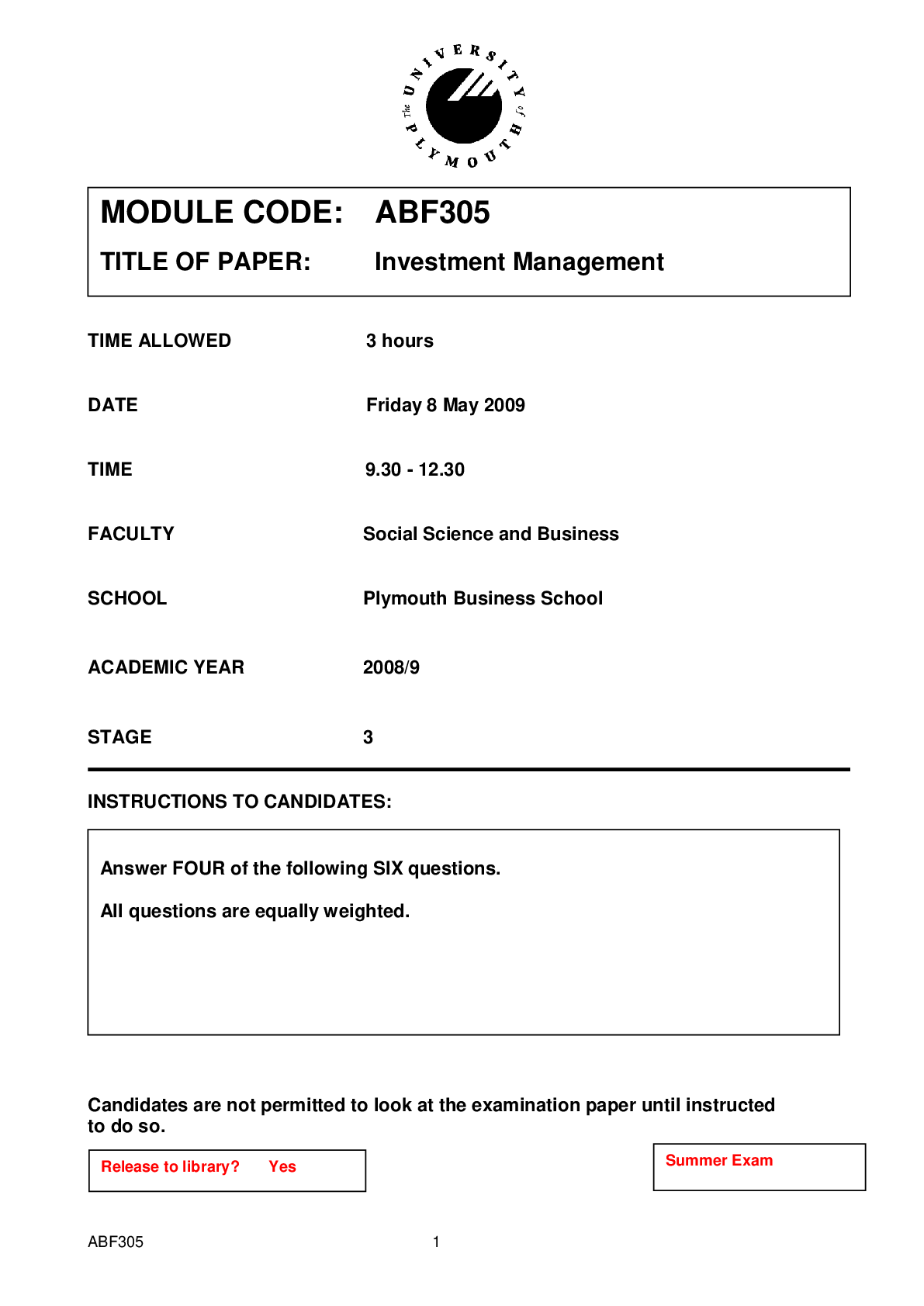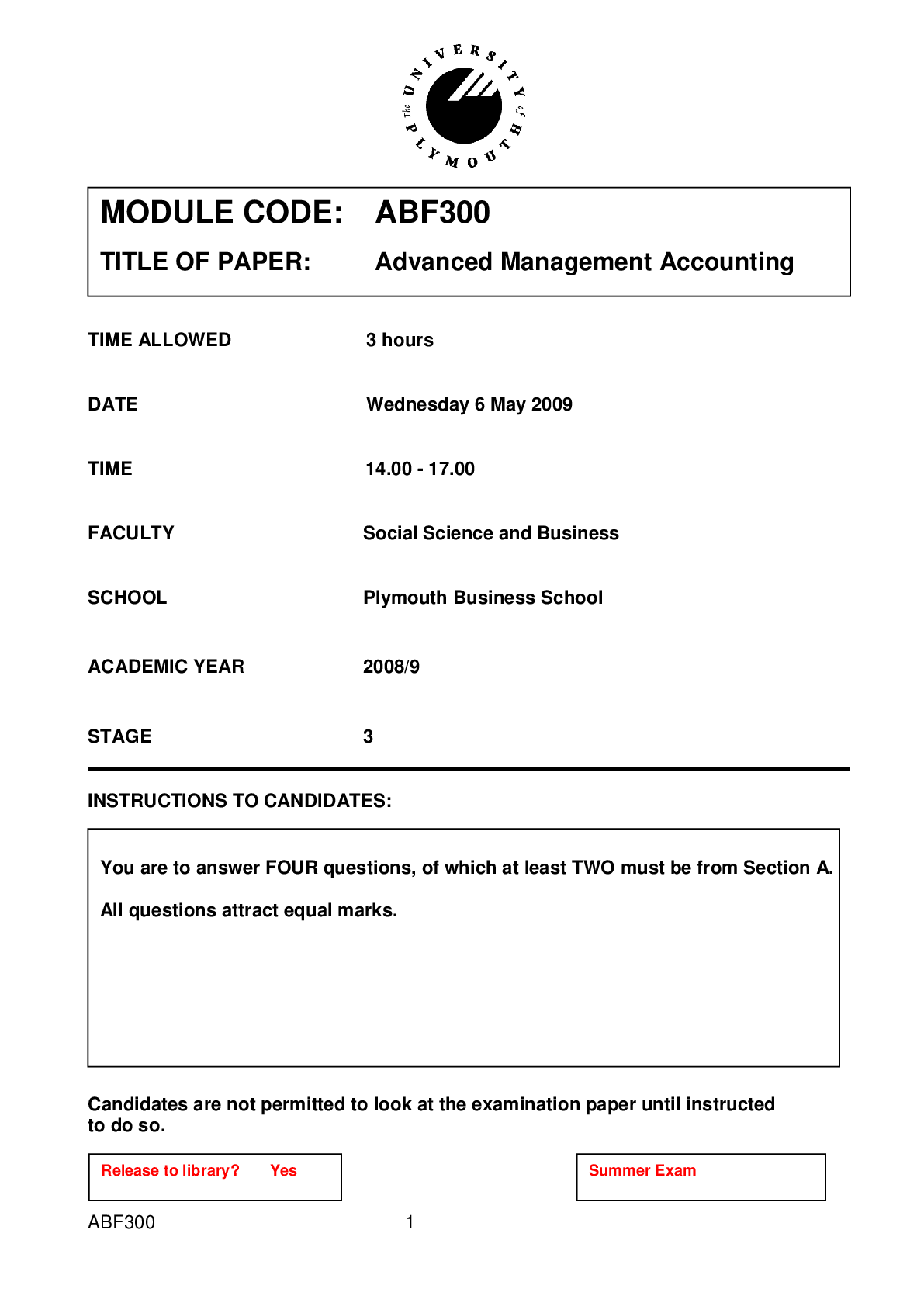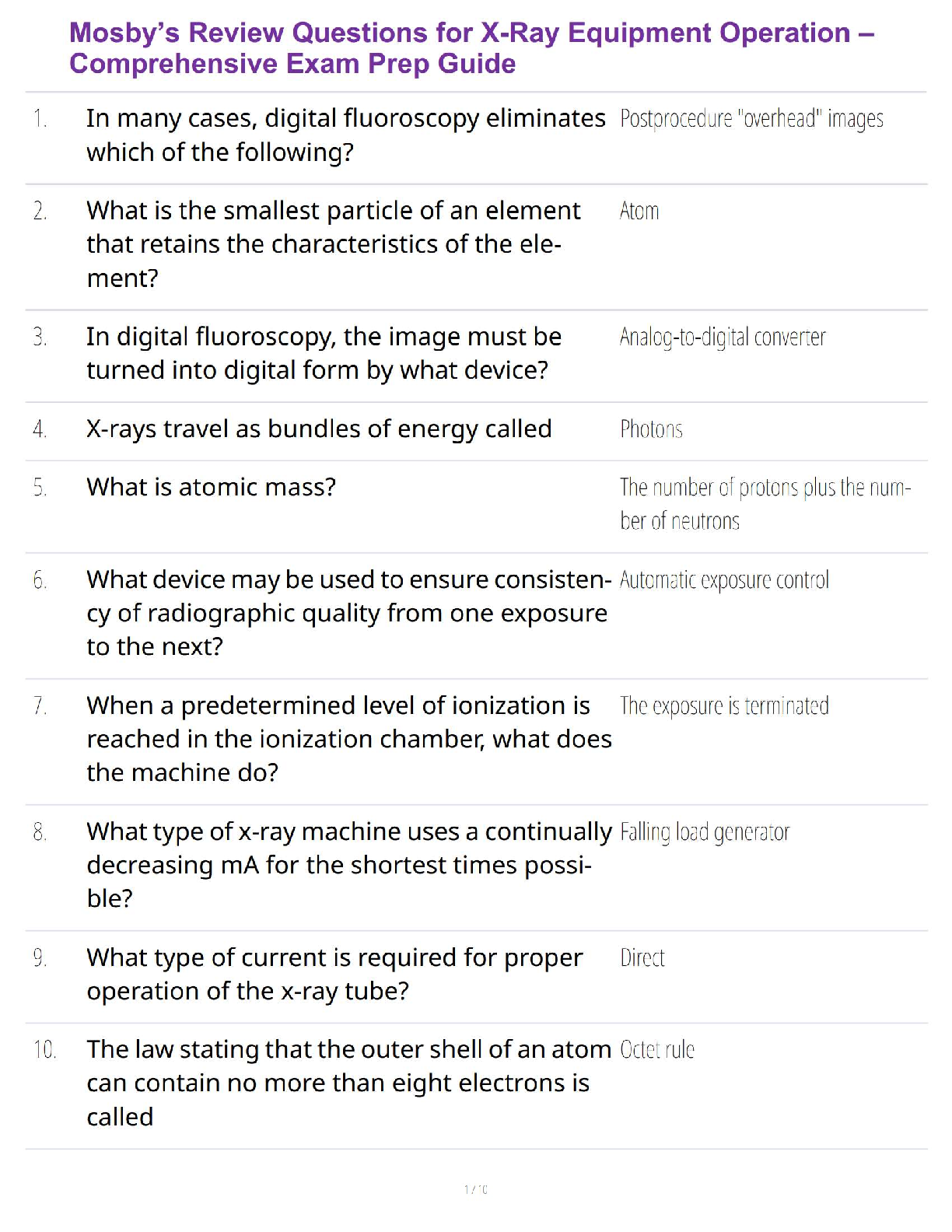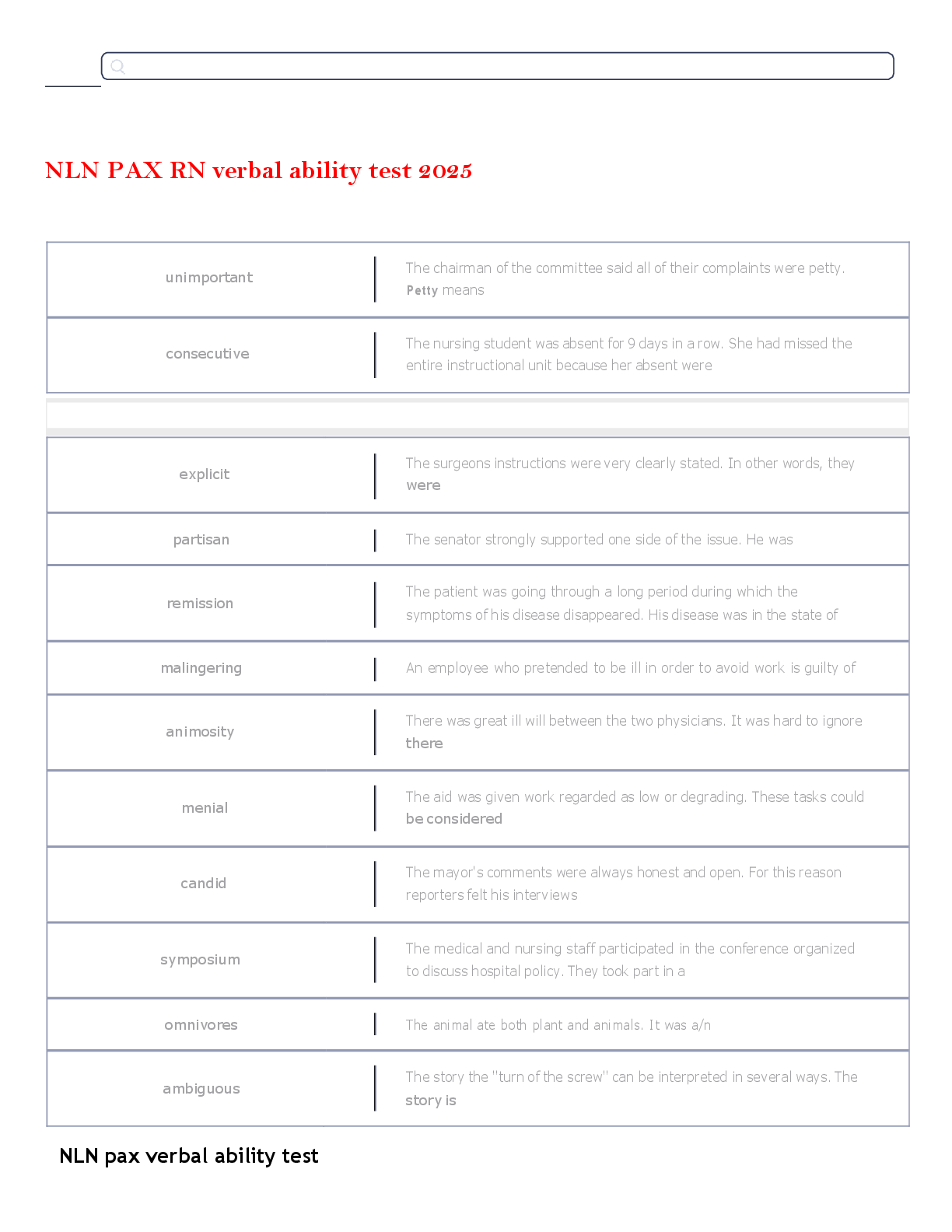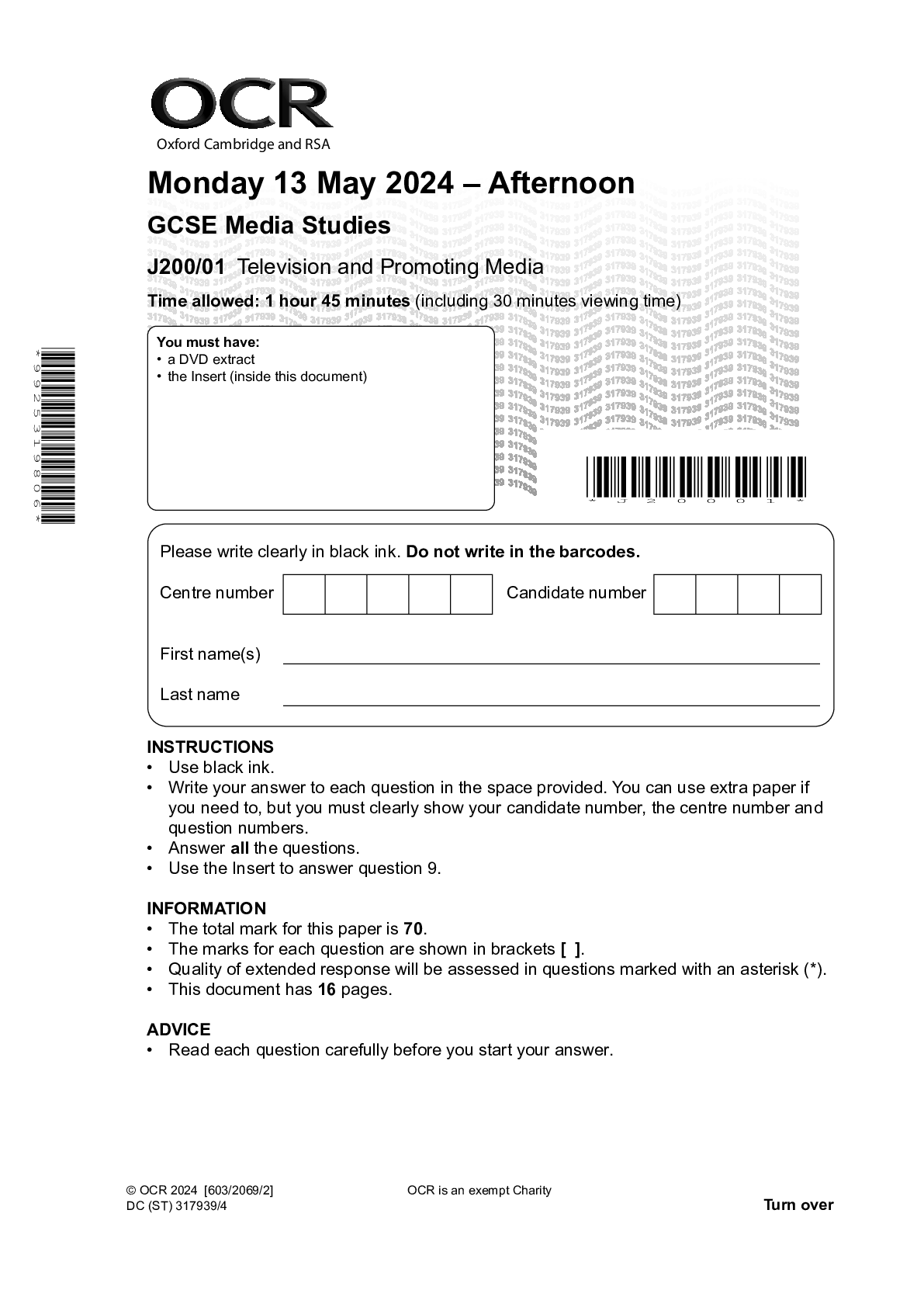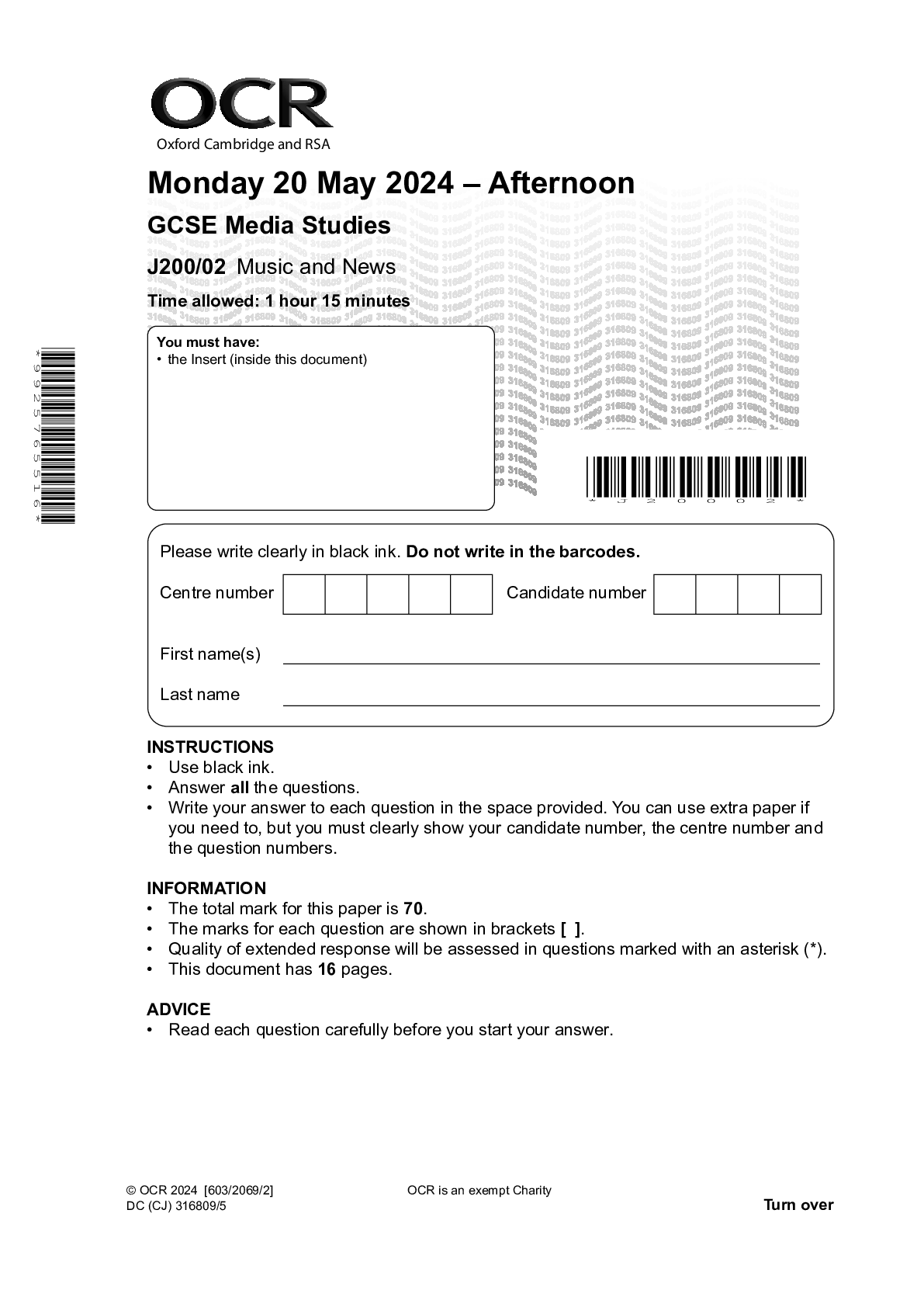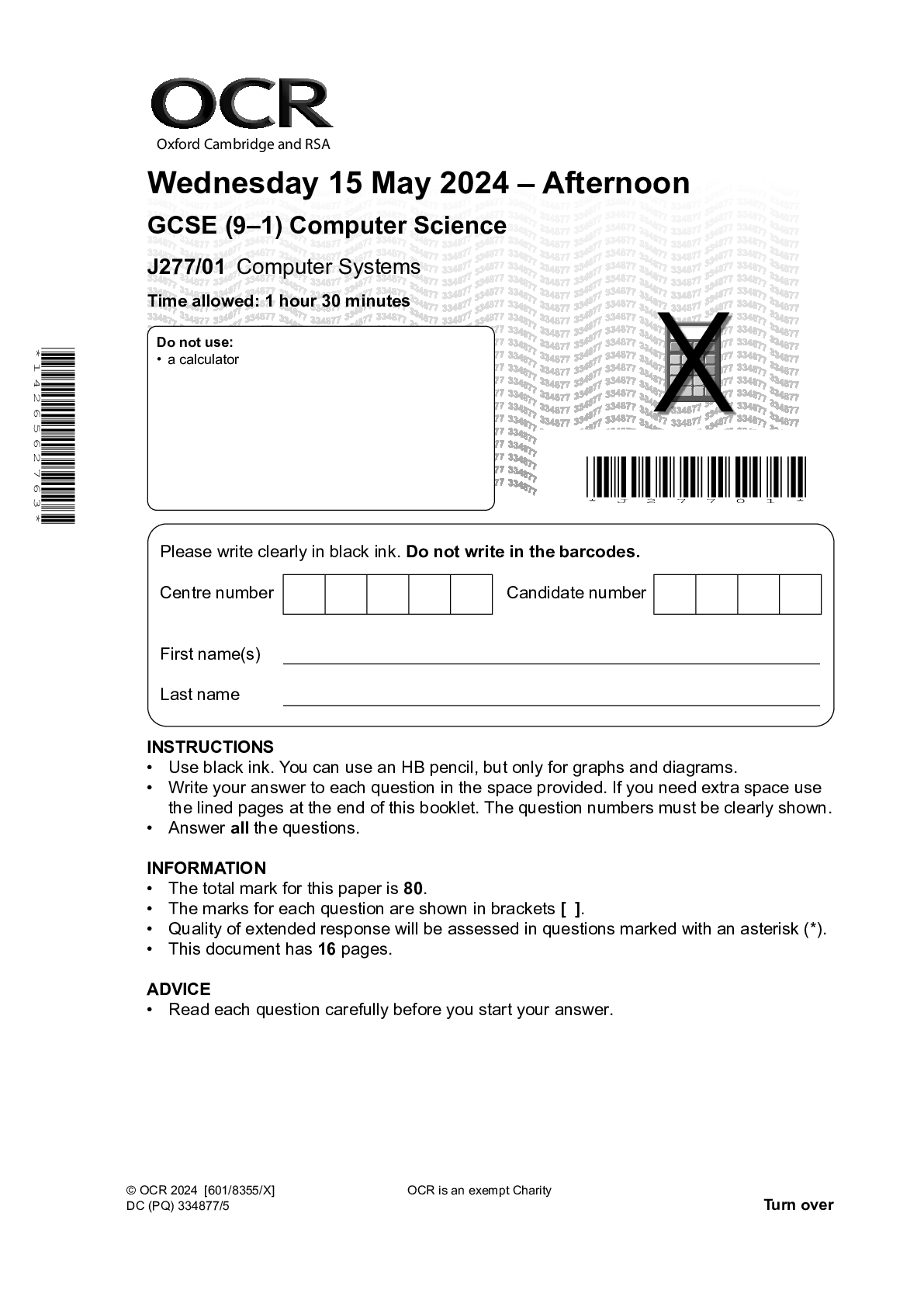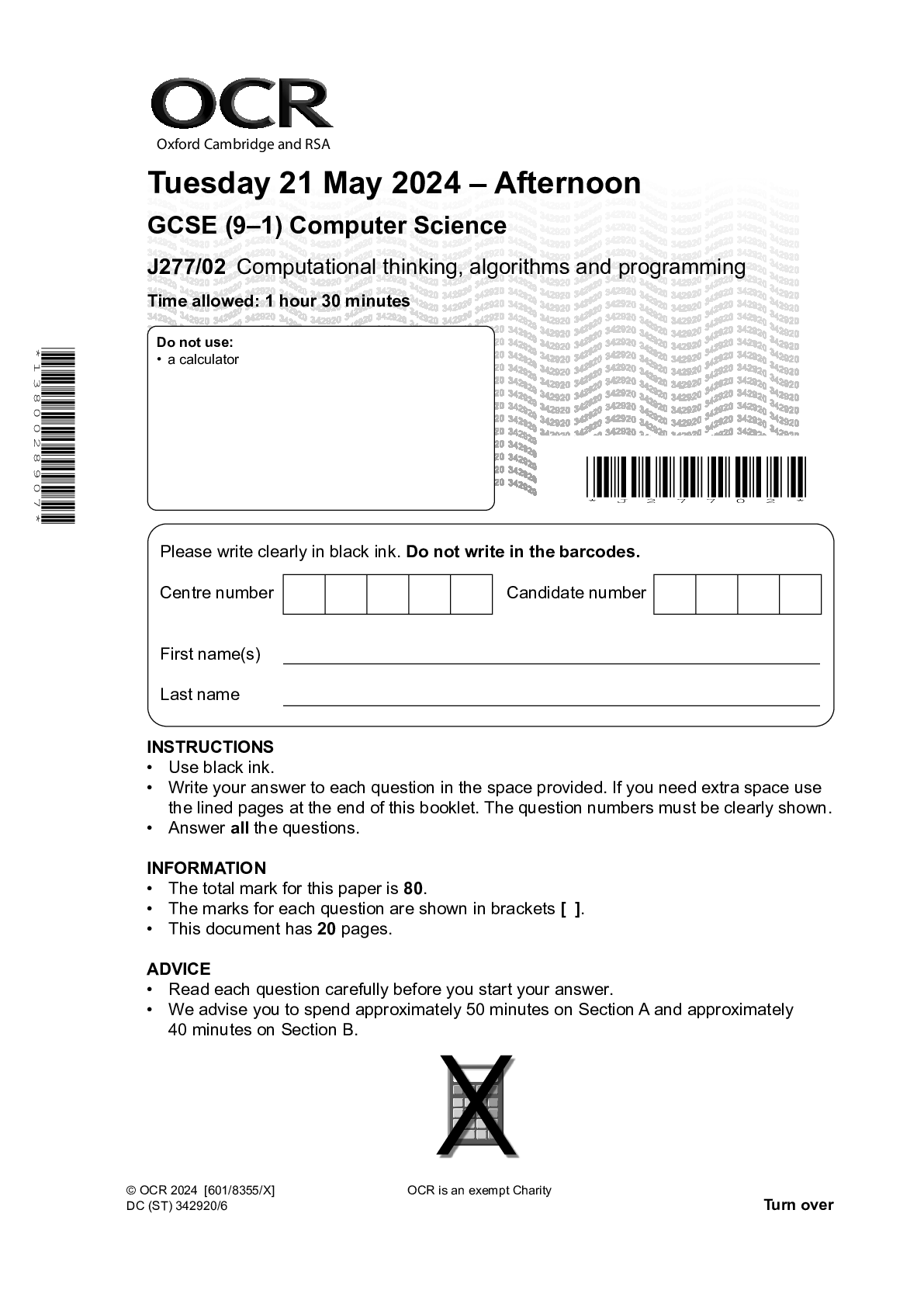Economics > QUESTION PAPER (QP) > Chapter 25 Transferability and Holder in Due Course. All Answers (All)
Chapter 25 Transferability and Holder in Due Course. All Answers
Document Content and Description Below
N.B.: TYPE indicates that a question is new, modified, or unchanged, as follows. N A question new to this edition of the Test Bank. + A question modified from the previous edition of the Test Ban ... k. = A question included in the previous edition of the Test Bank. TRUE/FALSE QUESTIONS A1. Under the UCC, a transfer of rights under a contract is a negotiation. F PAGE: 479 TYPE: = NAT: AACSB Reflective AICPA Legal A2. An order instrument is negotiated by delivery with any necessary indorsements. T PAGE: 479 TYPE: N NAT: AACSB Analytic AICPA Legal A3. Negotiation is a transfer in such form that the transferee becomes a holder. T PAGE: 479 TYPE: N NAT: AACSB Reflective AICPA Legal A4. A negotiable instrument can only be transferred by negotiation. F PAGE: 479 TYPE: = NAT: AACSB Analytic AICPA Legal A5. A special indorsement does not specify a particular indorsee. F PAGE: 480 TYPE: N NAT: AACSB Analytic AICPA Legal A6. An indorser who does not wish to be liable on an instrument can use a qualified indorsement. T PAGE: 481 TYPE: N NAT: AACSB Analytic AICPA Legal A7. The effect of a conditional indorsement on the back of an instrument is the same as the effect of conditional language that appears on its face. F PAGE: 483 TYPE: N NAT: AACSB Analytic AICPA Legal A8. Indorsement can convert an order instrument into a bearer instrument T PAGE: 484 TYPE: N NAT: AACSB Analytic AICPA Legal A9. An instrument payable to two persons jointly requires the indorsement of only one of the payees for negotiation. F PAGE: 486 TYPE: = NAT: AACSB Analytic AICPA Legal A10. A person who receives an instrument as a gift normally becomes an ordinary holder. T PAGE: 487 TYPE: + NAT: AACSB Reflective AICPA Legal A11. An executory promise does not constitute sufficient value to make the promisor a holder. T PAGE: 487 TYPE: N NAT: AACSB Analytic AICPA Legal A12. A holder does not take an instrument for value if he or she gives a negotiable instrument as pay¬ment. F PAGE: 487 TYPE: N NAT: AACSB Reflective AICPA Legal A13. For an ordinary holder to become an HDC, the holder must have acted honestly in the process of acquiring the instrument. T PAGE: 487 TYPE: N NAT: AACSB Analytic AICPA Legal A14. An instrument is not defective simply because it is overdue. F PAGE: 489 TYPE: = NAT: AACSB Reflective AICPA Legal A15. If a person purchasing an instrument does not know and has no reason to know that it has been dishonored, the person cannot become an HDC. F PAGE: 490 TYPE: N NAT: AACSB Analytic AICPA Legal A16. A person who acquires a check stamped “insufficient funds” is put on no¬tice and thereby acquires HDC status. F PAGE: 490 TYPE: = NAT: AACSB Reflective AICPA Legal A17. Knowledge of one defense precludes a holder from asserting HDC status in regard to all other defenses. T PAGE: 490 TYPE: + NAT: AACSB Analytic AICPA Legal A18. Any irregularity on the face of an instrument that calls into question its validity will bar HDC status. T PAGE: 492 TYPE: N NAT: AACSB Reflective AICPA Legal A19. A person who accepts an instrument that has been completed without knowing that it was incomplete when issued can take it as an HDC. T PAGE: 492 TYPE: N NAT: AACSB Reflective AICPA Legal A20. The shelter principle allows persons who formerly held instruments to improve their positions by later reacquiring the instruments from HDCs. F PAGE: 493 TYPE: N NAT: AACSB Analytic AICPA Legal MULTIPLE CHOICE QUESTIONS A1. Ollie negotiates an order instrument to Phil by a. assignment of its rights under a contract. b. delivery with any necessary indorsement. c. making an unconditional promise to pay. d. presenting it in response to a demand by B. B PAGE: 479 TYPE: = NAT: AACSB Reflective AICPA Legal A2. Lauren transfers an instrument to Miguel in a form and by a means that makes Miguel a “holder.” This is a. a holding. b. an assignment. c. negotiation. d. presentment. C PAGE: 479 TYPE: = NAT: AACSB Reflective AICPA Legal A3. Petra signs a check payable to Quincy, who in¬dorses the back, gives it to Regional Credit Union, and receives cash. The transfer of the check from Quincy to the credit union is a. an assignment. b. a negotiation. c. a payment. d. a sale. B PAGE: 479 TYPE: = NAT: AACSB Reflective AICPA Legal A4. Ivy signs a check payable to Jon and gives it to him. Jon in¬dorses the back, and transfers the check to Ked. To negotiate the check to Luis, Ked must a. write “Ked” on the back. b. write “pay to the order of Luis [signed] Ked” on the back. c. deliver the check to Luis. d. obtain Luis’s signature on the back. C PAGE: 479 TYPE: + NAT: AACSB Reflective AICPA Legal Fact Pattern 25-A1 (Questions A5–A8 apply) Rollo obtains a check payable to his order from Simone. Rollo signs the back and gives the check to Trey. Trey writes “Pay to Trey” above Rollo’s signature. A5. Refer to Fact Pattern 25-A1. When Trey writes “Pay to Trey” above Rollo’s signature, Rollo’s signature becomes a. a blank indorsement. b. a qualified indorsement. c. a special indorsement. d. a restrictive indorsement. C PAGE: 480 TYPE: N NAT: AACSB Reflective AICPA Legal A6. Refer to Fact Pattern 25-A1. When Trey writes “Pay to Trey” above Rollo’s signature, the check becomes a. a bearer instrument. b. an order instrument. c. a promissory note. d. a nonnegotiable instrument. B PAGE: 480 TYPE: N NAT: AACSB Reflective AICPA Legal A7. Refer to Fact Pattern 25-A1. By writing “Pay to Trey” above Rollo’s signature, Trey a. avoids the risk of loss from theft of the instrument. b. relieves himself from liability on the instrument. c. converts the check into a nonnegotiable instrument. d. locks the instrument into the bank collection process. A PAGE: 480 TYPE: N NAT: AACSB Reflective AICPA Legal A8. Refer to Fact Pattern 25-A1. After Trey writes “Pay to Trey” above Rollo’s signature, further negotiation of the check a. requires Rollo’s re-indorsement and delivery. b. requires delivery alone. c. requires Trey’s indorsement and delivery. d. is not possible. C PAGE: 480 TYPE: N NAT: AACSB Reflective AICPA Legal A9. Tiffany transfers a draft by signing it and delivering it to Uma. Tiffany is a. an indorser. b. a draft dodger. c. a drafter. d. a promisor. A PAGE: 480 TYPE: = NAT: AACSB Reflective AICPA Legal A10. Velma transfers a note by signing it and delivering it to Woz. Woz is a. a delivery person. b. an indorsee. c. a note passer. d. a promisee. B PAGE: 480 TYPE: = NAT: AACSB Reflective AICPA Legal A11. Mike receives a payroll check from National Computer Systems, Inc., and indorses it by signing his name on the back of the check. This is a. a blank indorsement. b. a qualified indorsement. c. a restrictive indorsement. d. a special indorsement. A PAGE: 480 TYPE: = NAT: AACSB Reflective AICPA Legal A12. Dora receives a check from Eagle Corporation. Dora in¬dorses the check to First National Bank by writing “pay to First Nat’l Bank only” and signing her name. This is a. a blank indorsement. b. a qualified indorsement. c. a restrictive indorsement. d. a special indorsement. C PAGE: 483 TYPE: = NAT: AACSB Reflective AICPA Legal A13. Gina writes and signs a check payable to “Happy Market.” Ira, Happy’s manager, indorses the check “For deposit only.” This is a. a blank indorsement. b. a qualified indorsement. c. a restrictive indorsement. d. a special indorsement. C PAGE: 483 TYPE: = NAT: AACSB Reflective AICPA Legal A14. To pay for investment advice from financial consultants Smith and Jones, Tony signs a check payable to “Smith or Jones.” A proper in¬dorsement of the check is a. not possible. b. “Smith” and “Jones” only. c. “Smith” only, or “Jones” only, but not “Smith” and “Jones.” d. “Smith” only, or “Jones” only, or “Smith” and “Jones.” D PAGE: 486 TYPE: = NAT: AACSB Reflective AICPA Legal A15. Blythe, an accountant for Credits & Debits, acquires a negotiable instru-ment from Eton by promis¬ing to pay its face value in thirty days. Blythe ac-quires the status of an HDC when she a. acquires possession of the negotiable instrument. b. agrees with Eton to buy the negotiable instrument. c. pays the face value due on the instrument. d. transfers the instrument to another party. C PAGE: 487 TYPE: = NAT: AACSB Reflective AICPA Legal A16. Jen makes a gift of a check to Kilroy who takes it in good faith and without notice of any claim, defense, or defect. With respect to this check, Kilroy is a. an extraordinary holder in due course. b. an ordinary check passer. c. an ordinary holder. d. an ordinary holder in due course. C PAGE: 487 TYPE: = NAT: AACSB Reflective AICPA Legal A17. Jill, in good faith and for value, gets from Kit a check “payable to the order of bearer.” Jill does not know that Kit stole the check. Jill is a. an HDC. b. not an HDC, because Kit did not acquire the check for value. c. not an HDC, because Kit did not acquire the check in good faith. d. not an HDC, because the check is a bearer instrument. A PAGE: 489 TYPE: = NAT: AACSB Reflective AICPA Legal A18. Florencia, who is not a GigaBank customer, attempts to cash a check drawn on the bank. The check is considered dishonored if GigaBank a. refuses to pay it. b. charges a fee to cash it. c. asks Florencia for reasonable identification. d. asks Florencia to sign a receipt for the payment on the check. A PAGE: 490 TYPE: N NAT: AACSB Reflective AICPA Legal A19. Bob receives a check from Chris. Without Bob’s knowledge, Dan indorses it in his own name and deposits it in his account at Elm City Bank. In Bob’s subsequent suit against the bank for the money, the court will most likely rule in favor of a. Bob, because Dan’s signature is not authorized. b. Bob, because Elm City Bank is not a holder in due course. c. Elm City Bank, because Dan’s signature is not authorized. d. Elm City Bank, because it is a holder in due course. A PAGE: 492 TYPE: = NAT: AACSB Reflective AICPA Legal A20. Clem gets a $100 check as a gift from Daria. Clem crudely increases the amount of the check to $1,00—the alteration is obvious—and transfers it to eReady Sets, Inc., in exchange for a 3D HD TV. eReady deposits the check in its bank account at First Town Bank. HDCs of this check include a. Clem, eReady, and First Town Bank. b. Clem only. c. eReady and First Town Bank only. d. none of these parties. D PAGE: 493 TYPE: = NAT: AACSB Reflective AICPA Legal ESSAY QUESTIONS A1. Eppie gives a check to Fund Investments to buy 100 shares of stock in GR8 Tech Corporation for Eppie. The price of the shares is constantly fluctuating. Fund Investments asks Eppie to leave the amount of the check blank and allow it to fill in the price when making the purchase. Eppie agrees. Fund Investments buys the stock when the price is $4,000, but fills in the check for $5,000. The check is negotiated as payment for a $5,000 debt to Hasty Accounting Services, which takes the check in good faith and without no¬tice of Fund Investments’s act. Hasty later learns that Fund Investments was not author¬ized to fill in the check for $1,000 over the price. Is Hasty an HDC? If so, for how much? A2. Colby fraudulently induces Dian to sign a note. Colby sells the note to Elen, who does not know of the fraud and takes the note for value and in good faith, and thus becomes an HDC. Elen sells the note to Fred, who sells the note back to Colby. Does Colby acquire Elen’s HDC rights in the note? [Show More]
Last updated: 3 years ago
Preview 1 out of 18 pages
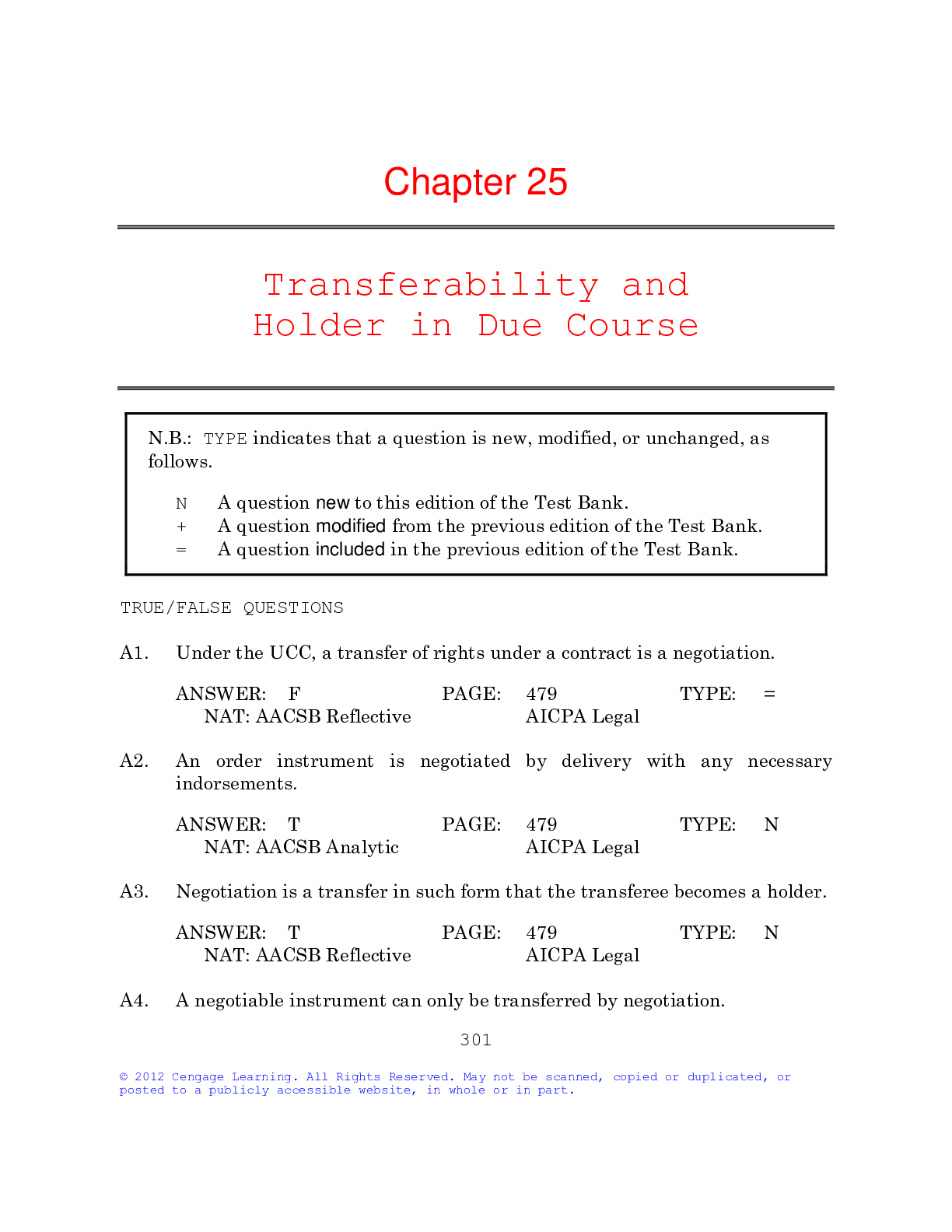
Buy this document to get the full access instantly
Instant Download Access after purchase
Buy NowInstant download
We Accept:

Reviews( 0 )
$6.00
Can't find what you want? Try our AI powered Search
Document information
Connected school, study & course
About the document
Uploaded On
Dec 13, 2019
Number of pages
18
Written in
All
Additional information
This document has been written for:
Uploaded
Dec 13, 2019
Downloads
0
Views
269








